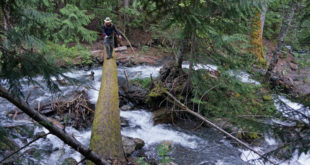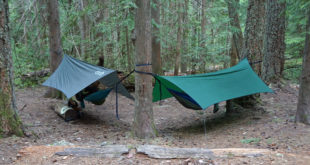About 4 or 5 months ago I had a box arrive from Columbia: A pair of their brand new Powerdrain shoes. I puzzled over what to do with them and at first look wasn’t sure they were a fit for me, but try them out I did and I found that in a very short time they became my go-to shoe for, well, pretty much everything.
The Powerdrains are somewhat of a minimalist shoe and the biggest goal they seem to have in mind is a water shoe, but in my experience they are much, much more.
If you’re new to Columbia or haven’t seen them in a while, you’ll be pleased to know that they’ve grouped their new products into different categories within their “OMNI” line. It makes it really easy to identify the key feature of the item. For example, these shoes are part of their OMNI-GRIP line. They use a high traction rubber that sticks really well to all sorts of surfaces, especially when wet, I can testify to that after taking them twice down one of Bolivia’s Incan trails where the 500+ year old stone trail is wet, steep and in many places polished to a slippery shine.
| Although not an aggressive tread, they handle smooth, wet and slippery surfaces incredibly well. |
The sole is divided into 4 parts, to make it more flexible and allow your foot to curve around uneven surfaces. It works really well, but may take a bit of getting used to if you’re accustomed to hiking boots. I prefer to hike in trail runners where the load suits it and really appreciate the flexibility. It reminds me of my summers as a child where I would go whole days through trails and streams barefoot, but with the added protection of rubber and foam soles. You do have to be careful of sharp rocks as the gaps between the rubber can poke at you, but it hasn’t caused any issues for me in the couple hundred kilometres I’ve taken these on roads and trails… mostly on trails.
| Hiking down an Incan path on La Isla del Sol the Powerdrains gave excellent traction, even when weighed down by two kids. |
When hiking down the Incan Trail (called the Choro Trail), I took my powerdrains, but planned to use another pair of trail runners and save the powerdrains for river crossings and slippery sections. The trail runners (ASICS) left my feet so sore and were so uncomfortable (even with my feet taped) that I switched to the powerdrains on the first day. I’ve never worn the other brand’s trail runners again. When I did the Choro Trail the second time I only took the Columbia Powerdrains and didn’t have a single problem descending the 11000 feet on the 40 mile trail.
Drainage
Because you can’t keep any shoe waterproof, Columbia designed the Powerdrain to allow water in, but get rid of it as soon and as fast as possible. It has a really cool system to allow it to do so, utilizing the uppers, the inner sole and the outer sole.
The upper has a mesh exterior and foam interior which is dotted with holes. These allow the shoes to breathe well and water to enter and exit easily.
The sole itself has 9 holes in it that allow water to flow through from the inside of the shoe and drain out. I’ve found this to be great as the water often gets trapped in my other shoes and keeps them soggy and uncomfortable. It’s pretty fancy and works well because of the design of the inner sole of the shoe.
| The screen of my Powerdrains after 3 days on the Choro Trail in Bolivia. |
The inner sole is perforated allowing any water that doesn’t exit through the sides to drain into the bottom and out through the holes. If you lift up the inner sole, you can see a fine mesh attached to the sole that allows water to flow through it, but prevents any small debris from getting stuck in the drainage ports of the outer sole.
Comfort and Lacing
One of the things that made me worried about taking the Powerdrains on hard hikes was the lacing system. It uses one of those elastic pull systems, but the quality is all there. Despite my fears, it never slipped (unlike my shoes, even when using a double bow!). It always stays snug on my foot, but the elastic allows the lacing to stretch just enough when moving to keep your shoe from getting uncomfortable.
Their light weight and flexibility make them a very comfortable shoe.
Toe Cap
A huge benefit to this shoe is its toe cap. It’s a strong synthetic that keeps your toes from getting dinged up on rocks, but it does have a downside (on the 2012 model) that Columbia says they’re fixing for next year (2013). The toe cap is starting to separate on both of my shoes after a couple hundred kilometers of very hard use. Also, where the outer mesh of the shoe’s upper connects to the corner of the toe cap it has worn through from abrasion. Now, this is after a lot of hard use, and it’s really only an aesthetic problem at this point. It hasn’t compromised the structure or quality of the shoe.
That is the only real downside I have to the shoe, and that’s not much. I look forward to seeing how Columbia has planned to fix it for next year.
Overall thoughts
The Powerdrain is an excellent shoe that serves for almost every walking or hiking situation. To call it a water shoe is to insult its capabilities. They can handle rough terrain, steep uphill and downhill and are excellent on slippery terrain. The drainage system is well thought out and very effective. Oh, don’t expect the withe and yellow to stay white for very long!
I’m seriously considering taking a 2013 pair like these on the John Muir Trail next summer.
If you’re looking for a lightweight minimalist shoes for hiking and trails, especially where you expect it to be wet and slippery, check these out, you won’t be disappointed.
 The Outdoor Adventure Giving you tips, tricks & recommendations to help make adventuring in the Outdoors fun, safe & exciting for you and your kids.
The Outdoor Adventure Giving you tips, tricks & recommendations to help make adventuring in the Outdoors fun, safe & exciting for you and your kids.





